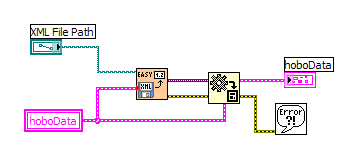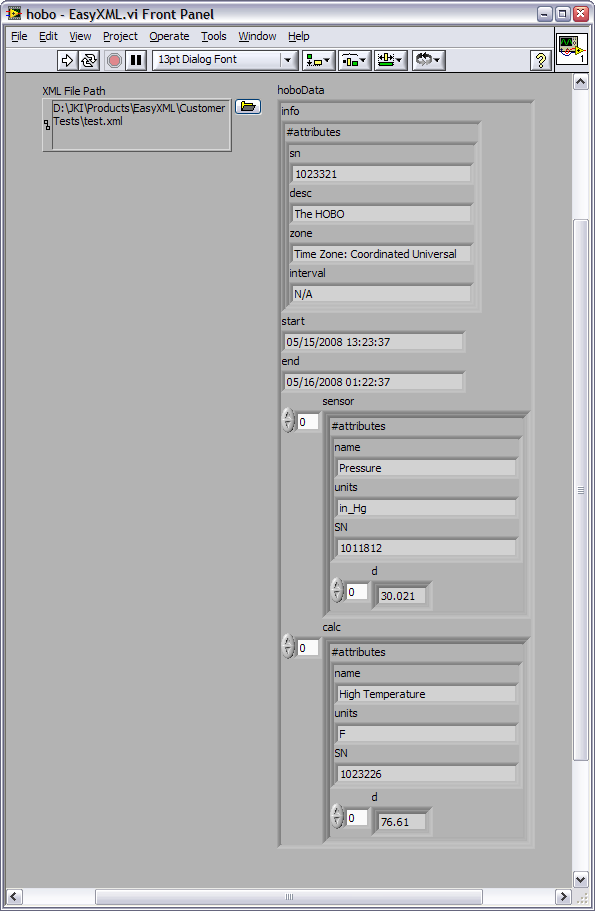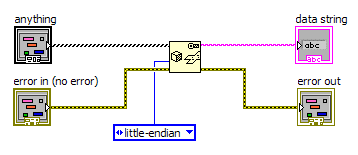-
Posts
3,905 -
Joined
-
Last visited
-
Days Won
34
Content Type
Profiles
Forums
Downloads
Gallery
Posts posted by Jim Kring
-
-
AQ: In situations where there are several valid choices in behavior, why not prompt the user to choose (and maybe give them an option to not ask again and use their current choice in the future, if that's appropriate)?
Mike: It sounds like you've been spoiled by great programs like TortoiseSVN that, when you rename a file (like changing a prefix), will find other files next to it with similar names (that you are likely to want to rename) and ask you if you want to apply the same renaming operation to them, too. Maybe one day LabVIEW will have a great feature like this, too

-
QUOTE (okeen @ Mar 24 2009, 03:46 PM)
Here's an example of how to use EasyXML to do this:
Download File:post-17-1237937606.vi
PS -- come on Omar, why not post an example

-
QUOTE (xuniL @ Mar 22 2009, 08:23 PM)
I'm part of a small and growing LabVIEW-based consulting company that has outgrown its peer-to peer network and looking for the best file server solution. I'm hoping to learn from somebody else's experience and maybe even get a little debate going.a. Buying a new full-blown server running Microsoft Windows Small Business Server 2008
Good luck,
-Jim
-
-
QUOTE (gmart @ Mar 18 2009, 03:13 PM)
A clarification. A project ,by itself, does not load VIs into memory when it is loaded. It is able to determine what dependencies are needed/used without loading VIs into memory. The project does load project items such as libraries or classes which may load VIs.Hi George,
I apologize, in advance, for not reading this whole thread (or testing to answer my own question, below). I just have a quick question:
Are lvlib members really also loaded into memory when the project is loaded? I thought that only class members were loaded into memory when the project was loaded.
Thanks,
-Jim
-
QUOTE (benjaminhysell @ Feb 24 2009, 08:58 AM)
I thought I would poke this thread and see if we can get it started again...In the past six years doing TDD I've only actually unit tested a handful of private class methods, I would say less than four. I subscribe to what I feel is the overall tone of this thread, we shouldn't be testing private methods for all of the reasons given above.
However, that said, I agree with Jim, if I know what I am getting into there should be a method to unit test private methods.
In VS2008 you can do it, however they really make you really work for it, there is a whole dance you need to go through with reflection to load the assembly and to unit test it. It is a pain, but it can be done.
I think as VI Tester goes forward it would be nice to have the option, but an option that has a cost to the developer. Inflicting this cost would make a developer think twice about wanting to actually do the unit testing this way, and may in turn cause them to refactor their code to a cleaner implementation if at all possible.
We've given a little thought about how we might be able to unit test private methods, but none of them are easy, to say the least. This will probably be a very low priority, in the near term.
-
Has anyone encountered this? I have a customer who complains about the following:
When I start LabVIEW 8.6 with my network connection active, it takes a long time. But, with the network disabled/unplugged, it starts up very quickly. It's worth noting that this doesn't happen in 8.2
Any LabVIEW.ini keys or other settings that might help?
-
Since (I think) nobody has mentioned it, yet, Agilent VEE has a feature like this and I never really understood or liked it.
-
Hi Tomi,
Congratulations on this big step. I have no doubt Agile4 will be a success

-Jim
-
-
Update: CAR 148149 assigned by NI.
-
QUOTE (Aristos Queue @ Feb 23 2009, 01:48 AM)
An easier solution would be to
-
open and edit the typedef,
-
don't save any other changes,
-
close all VIs,
-
reopen the project, and then
-
save all changes.
QUOTE (ned @ Feb 23 2009, 07:25 AM)
Aahh, the frustration. I never knew that Register for Events accepts a cluster of user event references (and I haven't seen it documented anywhere). Do I take advantage of this trick to clean up my code, or stay away from it to avoid this bug?Unfortunately, avoiding clusters won't help you avoid this bug.
Below, is another example using scalars and multiple event terminals on the Register for Events node
Short Video Demonstration of the Bug (using scalars instead of clusters)
And, here's an example VI that you can use to test it for yourself:
Download File:post-17-1235412403.vi
Steps to Reproduce
- Open "Dynamic Events Bug (scalars).vi"
- Cycle through the Event Structure frames
- Note the contents of the frames for Event A, Event C, and Event D.
- Note the cluster constant with user event reference constants for Event A, Event B, Event C, and Event D
[*]Delete the Event B user event constant.
[*]Right-click on the second User Event terminal on the Register for Events node and choose Remove Element.
- Note the contents of the frames for Event A, Event C, and Event D.
Observed Results
- Cycle through the Event Structure frames
- Note that contents of the Event Structure frames for Event C and Event D got swapped: the contents for Event C are now associated with Event D.
- Note that contents of the Event Structure frames for Event C and Event D got swapped: the contents for Event C are now associated with Event D.
Expected Results
- The contents of the Event Structure frames for Event C and Event D should remain unchanged (they should not be swapped)
-
open and edit the typedef,
-
QUOTE (neBulus @ Feb 22 2009, 07:17 AM)
Thank you very much for the heads up Jim! :thumbup:I wonder if that is realated to ?CAR# 117209 ? where edits of a type def cluster could show an analogous effects.
 The suggested work-around was to edit the type def with the callers closed and only open them after the change. I worked up a duplicate of your code in LV 8.5 and duplicated the bug you demoed.
The suggested work-around was to edit the type def with the callers closed and only open them after the change. I worked up a duplicate of your code in LV 8.5 and duplicated the bug you demoed.I converted it over to a type def version and achieved a similar effect by deleting an element from the type def hit apply changes, then did an un-do in the typed def and hit apply changes again.
I then backed-up and tried the edit of the typed def with the caller closed and it did not mix up the events.
So editing type def with callers closed may help you work-around/avoid this issue. Yes I am assuming you are using type defs in your real code.
Just trying to help,
Ben
Hi Ben,
Thanks for the information. This is very helpful.
The only problem that I see with the work-around you mentioned (editing type def with callers closed) is that I use classes a lot. And, having any member of a class (e.g., a type definition that is a member of a class) will cause all class members to be loaded into memory (e.g., VIs with Event Structures whose dynamic events use the type definitions).
Thanks,
-Jim
-
[CAR 148149]
Background
There is a bug in the Event Structure where code in frames of an Event Structure can get re-associated with a different/wrong Dynamic Event when the input event reference data of a Register For Events node changes.
Short Video Demonstration of the Bug
And, here's an example VI that you can use to test it for yourself:
Download File:post-17-1235239395.vi
Steps to Reproduce
- Open "Dynamic Events Bug.vi"
- Cycle through the Event Structure frames
- Note the contents of the frames for Event A, Event C, and Event D.
- Note the cluster constant with user event reference constants for Event A, Event B, Event C, and Event D
[*]Delete the Event B user event constant from the cluster constant.
Observed Results
- Cycle through the Event Structure frames
- Note that contents of the Event Structure frames for Event C and Event D got swapped: the contents for Event C are now associated with Event D.
Expected Results
- The contents of the Event Structure frames for Event C and Event D should remain unchanged (they should not be swapped)
-
QUOTE (MikaelH @ Feb 19 2009, 03:49 PM)
I can of cause add a checkbox that allows the tool to delete any existing method before, but that's a bit scary.If I add an automated backup feature of the deleted/removed method then it would be quite safe.
We're just about to release a new version and I'll see if I can squeeze this function in.
You can clone a method (from the base class), to one or all siblings, see image below:
I haven't added the function of sending a method to several other classes but it's a small task to do that.
I can create a beta version for you during the weekend if you are interested?
> I can of cause add a checkbox that allows the tool to delete any existing method before, but that's a bit scary.
How about adding an OK/Cancel confirmation dialog letting the user know that pressing OK will overwrite existing files (if that's the case). That wouldn't scare me at all. Plus, I use Subversion and commit my code very frequently

> You can clone a method (from the base class), to one or all siblings, see image below:
How about adding another option for New VI Owner called "<Clone VI to Selected Sibling Classes>" that populates the bottom list with a list of all the sibling classes?
> I can create a beta version for you during the weekend if you are interested?
Of course I am

Thank you very much,
-Jim
-
QUOTE (Jan Klasson @ Feb 19 2009, 01:41 AM)
QUOTE (MikaelH @ Feb 19 2009, 05:02 AM)
GOOD NEWSthis feature works on normal LVClasses made without the GDS tool.(Of cause I can't understand how you can work with classes without this tool ;-)The function also supports cloning one base class method to several child classes at once.So install the GDS tool, and just right click on the VI, and select GOOP->Clone VI...Hi Jan and Mikael,
Thanks for the tip. I actually did already look in the GDS tool (which I have installed and use, regularly) and was not sure what "Clone VI" did.
I tried it, but it doesn't work for me. Here are the problems:
1) My sibling class already has an instance of the method that I'm trying to clone. The GDS "Clone VI" dialog will not permit me to make a clone that overwrites/replaces an existing method.
2) The GDS "Clone VI" dialog only permits sending the new clone to a single class. I want to send it to about 30 sibling classes. Ideally, I don't want to have to do a "Clone VI" operation 30 times.
Thanks,
-Jim
-
-
I have a situation where I need to duplicate some code in sibling methods. Ideally, I would put this code inside the parent class, but for performance reasons (I don't want to use variants) and a limitation in LabVIEW's edit-time type adaption/propagation, the code must in the child class.
This means that every time I want to change the implementation of my code, I have to duplicate the code in the sibling methods. What I'm looking for is an easy way to copy a method into a sibling. Now, I can sort of do this with a "Save a Copy As" operation, but then I have to manually relink the copy to the sibling classes data types (such as the object/class-private-data, etc.).
Has anyone solved this problem? I'm tempted to try to automate this using either scripting or by modifying the linker info on disk, as described below:
Copy "ClassA.lvclass:Method.vi" (<MyProject>/ClassA/Method.vi) to "ClassB.lvclass:Method.vi" (<MyProject>/ClassB/Method.vi) on disk. Modify the linker info of "ClassB.lvclass:Method.vi" (<MyProject>/ClassB/Method.vi) on disk, such that every instance of "ClassA.lvclass" in the linker info is replaced by "ClassB.lvclass".
I've got to do this periodically for about 30 sibling classes, so it's starting to make sense to automate this task.
-
Hi John,
Thanks for posting this. This is very cool in several different dimensions! :thumbup:
-Jim
-
-
In the Project Explorer hiding both the "Standard" and "Project" toolbars hides all toolbars the next time project is opened.
Steps to reproduce:
1) open a new project
2) hide the "Standard" and "Project" toolbars, by right-clicking on the toolbar and unchecking them
3) show at least one other toolbar (such as "Build" or "Source Control")
4) close the project
5) open new project
==> note that all toolbars are hidden -- THIS IS A BUG
6) right-click on the toolbar and show the "Standard" or "Project" toolbar.
==> note that several previously hidden toolbars are now visible
-
QUOTE (neBulus @ Feb 12 2009, 01:07 PM)
Actually he is an XBoxer- call of Duty type. I asked him to think about writting something up after he started to rattle off a buch of stuff but stopped and said, It's really complicated!". He did say he would try to put something together.Hi Ben,
Thanks for asking him.
> "It's really complicated!"
All the more reason for us to be sharing our info

Thanks,
-Jim
-
QUOTE (neBulus @ Feb 12 2009, 11:40 AM)
I can't give you an exhaustive list but here are some notes (well at least one worth reading)1) Property nodes executed prior to the web-srever being fully up do not always work. We were setting the string for a ring control too early and they would not show up. Doing so after the server was running no issues.
2) Whenever possible, find a young co-worker to develop the app. It saved me a lot of headaches.
3) A sign on the side of the equipment cabinet reading something to the effect "Warning! Parking this cabinet over a high pressure steam vent is a very bad idea."
Well at the least the first one was worth sharing.
Ben
Hey Ben,
Thanks for the info.
Would any of your "young co-workers" have any info they'd like to share, too? Or, are they too busy Twittering and Facebooking with thier IM buddies? :laugh:
-Jim
-
QUOTE (jlokanis @ Aug 19 2008, 10:15 PM)
John,
Thanks for stirring up that conversation. It was very enlightening.
I'm curious: have you (or anyone else here at LAVA) had success in deploying web services in LabVIEW? The process seems very non-trivial and I'm wondering if those who have tried it have any advice, best practices, or list of gotchas that they could share.
Thanks,






Renaming Parent dynamic dispatch VIs don't rename children
in Object-Oriented Programming
Posted
QUOTE (Aristos Queue @ Mar 26 2009, 07:21 AM)
I'm sorry if my post made it sound like I was complaining. I was simply making a feature suggestion.
Regarding priority: if it was really important, I would have been much more emphatic (or possibly written a tool to do it myself) -- you know how passionate I get when I'm really excited or pissed about something
Now, if you'd like to show me your list of 100 editor UI improvements, I would be happy to review and prioritize them
Thanks for all your hard work -- it seems like we've all been asked to do more with less, lately.